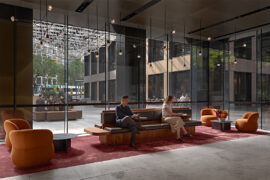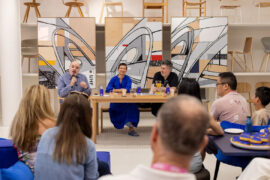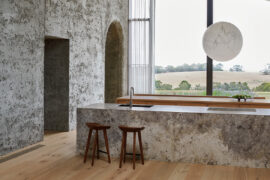If the 2017 global Shaw Contract Design Awards revealed anything, it’s that Australian designers really know how to embrace change and take a risk.
When you’re up against 500 global design projects vying for the top award, the stakes are nothing but high. Among this year’s Global Award Winners in the Shaw Contract Design Awards are FJMT’s Frank Bartlett Library and Service Centre in Moe. The People’s Choice Winner meanwhile emerged as SCHIN Architects’ Ground Floor Reid Library Refurbishment in Perth. It’s a big coup for the two Australian design firms, who competed against a world’s worth of talent: 497 entries from 32 countries.
Awards judge and managing principal at architectus, Andrew Schunke, was one of the four expert judges assessing this year’s Finalists entries. If this year’s judging process revealed anything, he says, it’s that “Australian designers push boundaries. We adopt a people focused design solution that celebrates our unique light and spatial understanding,” he says.
With so many design awards available to us in the Australia, Schunke is no stranger to the awards drill. In his view it takes a unique awards program to really stand out. “As an international awards program, the Shaw Contract Design Awards captures a broad range of project types, scales and design professional submissions without being elitist or style driven. The quality and thoughtful submissions reflected the esteem in which these awards are held and the personal approach to awarding the winners creates a very memorable experience for the design teams,” he says.
Schunke was on the ground in New York for the Finalists judging, joining three other US judges – all independent industry experts. “We spent a number of days getting to know each other and the shortlisted projects. We discussed and debated the merits of each project at length with many heated and varied outcomes.”
Five projects hailing for the US, Thailand and Australia, emerged as the clear winners – “each one standing out for different reasons, but with a clarity of design thought and experience focused outcome”, notes Schunke.
While the caliber of entries varied widely the winners were clear trend setters. Within that mix, the Australian projects revealed a “maturity and clarity of thought that showed us [that is, Australia] as continued leaders in interior design on the world stage”, Schunke says.
INDESIGN is on instagram
Follow @indesignlive
A searchable and comprehensive guide for specifying leading products and their suppliers
Keep up to date with the latest and greatest from our industry BFF's!

For Aidan Mawhinney, the secret ingredient to Living Edge’s success “comes down to people, product and place.” As the brand celebrates a significant 25-year milestone, it’s that commitment to authentic, sustainable design – and the people behind it all – that continues to anchor its legacy.
The new range features slabs with warm, earthy palettes that lend a sense of organic luxury to every space.

Grimshaw has completed a revitalisation of Collins Place, adding new layers to an already historically and architecturally rich site in Melbourne’s CBD.

An exhibition titled ‘Synthetic Spaces’ by Maycon Sedrez and Gregory Pitts from Deakin University is taking place at the Bates Smart Gallery in Melbourne.
The internet never sleeps! Here's the stuff you might have missed

London-based design duo Raw Edges have joined forces with Established & Sons and Tongue & Groove to introduce Wall to Wall – a hand-stained, “living collection” that transforms parquet flooring into a canvas of colour, pattern, and possibility.

The Richmond precinct will be one of the busiest hubs of Saturday Indesign 2025, with a full program of talks, product launches, installations, hospitality and entertainment running throughout the day.

The INDE.Awards 2025 has named House on a Hill by Leeton Pointon Architects and Allison Pye Interiors as the winner of The Interior Space category, presented by Tongue & Groove. This multigenerational country home on Bunurong Country redefines residential architecture and design with its poetic balance of form, function, and sanctuary.